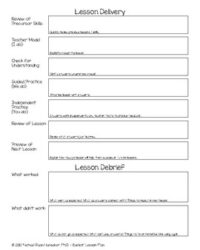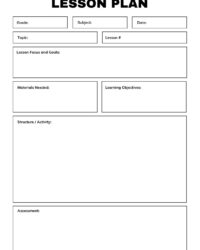Have you ever wondered what truly makes a great lesson? It is not just magic or spontaneous brilliance; it is often the direct result of careful, thoughtful preparation. Think of a lesson plan as your educational blueprint, a detailed roadmap that guides both you and your students through the entire learning journey. It brings essential structure, clarity, and purpose to every minute you spend in the classroom, whether you are teaching in a traditional setting or virtually.
Diving deep into the anatomy of a lesson plan template means understanding the vital components that make it function effectively. It is about breaking down the complex into manageable, actionable parts, ensuring you cover all your bases and create a rich, engaging learning experience every single time. Let us unearth these essential components together, turning what might seem like a daunting task into a clear, empowering process.
Deconstructing the Core Components of an Effective Lesson Plan
At its heart, an effective lesson plan is a strategic document designed to maximize learning outcomes. It moves beyond just jotting down notes; it is a thoughtful anticipation of the entire learning process, identifying precisely what needs to be taught, how it will be taught, and crucially, how its effectiveness will be measured. This comprehensive approach ensures that every moment in the classroom is purposeful and contributes to student growth.
Before you even think about the activities, every robust lesson plan starts with absolute clarity on direction. This involves pinpointing the specific topic or subject matter you are addressing and, more importantly, defining what students should be able to know or do by the end of the lesson. This foundational step sets the stage for everything that follows.
Setting Clear Objectives and Learning Outcomes
These are the North Star of your lesson. What exactly do you want your students to achieve by the time the lesson concludes? Good objectives are often crafted to be Specific, Measurable, Achievable, Relevant, and Time-bound. They serve as a clear guide for your instruction and provide a precise benchmark for assessment. For instance, instead of a vague “Students will learn about space,” a much stronger objective might be “Students will be able to identify and describe the four inner planets of our solar system.” This clarity benefits both the teacher and the learner.
Gathering Necessary Materials and Resources
No journey is complete without having the right tools at hand. This section of your lesson plan outlines everything you will need to facilitate the learning process: textbooks, worksheets, digital tools, art supplies, laboratory equipment, or even multimedia presentations. Planning these materials in advance saves valuable teaching time and ensures a seamless flow during the lesson. It is also wise to consider any prerequisite knowledge or skills students might need before embarking on the new topic, and how you might address any gaps.
Once the foundational elements are firmly in place, you then delve into the actual flow of the lesson. This is where you meticulously map out the sequence of activities, discussions, and instructional strategies you will employ to help students meet those pre-defined objectives. Typically, this section includes a captivating introduction or “hook,” direct instruction, opportunities for guided practice, independent practice, and a concise wrap-up.
Designing Engaging Procedures and Activities
This element represents the dynamic core of your lesson plan, outlining the step-by-step actions you and your students will take. How will you introduce the topic in a way that immediately grabs their attention? What diverse teaching methods will you use—perhaps a lecture, collaborative group work, an inquiry-based investigation, or a hands-on experiment? Critically, how will you facilitate consistent student engagement and active participation throughout the entire lesson? Thinking about varied activities that cater to different learning styles and help maintain energy levels is key to a truly successful lesson.
Implementing Effective Assessment Strategies
How will you truly know if your students have grasped what you intended for them to learn? Assessment extends far beyond just assigning grades; it is fundamentally about gauging understanding and providing timely, constructive feedback. This section specifies how you will check for comprehension throughout the lesson, through formative assessments like quick checks, classroom discussions, or exit tickets. It also outlines how you will measure overall learning at the end, through summative assessments such as quizzes, projects, or presentations, ensuring a holistic view of student progress.
Finally, a truly comprehensive lesson plan takes into account the diverse needs within your classroom and considers what happens after the instructional time.
Planning for Differentiation and Extension
It is a fundamental truth that not all students learn at the same pace or in the same way. This crucial component involves thoughtfully considering how you will provide support for struggling learners through targeted remediation, and simultaneously how you will provide enriching challenges for advanced students through extension activities. This proactive planning ensures equitable access to learning and maximum growth for everyone in your class.
Assigning Homework and Follow-up Tasks
Learning very often extends beyond the confines of the classroom. This part of the plan outlines any assignments designed to reinforce concepts, provide additional practice for developing skills, or prepare students for future lessons. It serves as an invaluable opportunity for students to consolidate their understanding independently, solidifying new knowledge and mastering emerging skills at their own pace.
Beyond the Basics: Enhancing Your Lesson Plan Template
While the core components form the robust backbone of any effective lesson plan, some additional elements can truly transform a good plan into an outstanding one. These finer details elevate your teaching from merely delivering content to fostering a dynamic, highly engaging, and inclusive learning environment where every student can thrive. They add layers of foresight and strategic thinking that enhance the overall educational experience.
Considerations like precise time allocation and the inclusion of a dedicated space for reflective practice are often overlooked, yet they are immensely powerful tools. They help you stay efficiently on track throughout the lesson and, perhaps even more importantly, enable you to continuously improve your teaching craft over time.
-
Time Management: Allocating specific timeframes for each segment of your lesson is incredibly helpful. It keeps you on schedule, ensures you cover all planned content, and helps you identify where you might need to adjust your pacing in real-time if needed. Remember, it is designed to be a flexible guide, not a rigid prison, allowing for natural classroom dynamics while maintaining structure.
-
Reflection and Notes: Often positioned at the very end of the template, this space is dedicated to your personal notes after the lesson has concluded. What worked exceptionally well during the lesson? What aspects did not go as planned, and why? What would you change or improve for next time you teach this content? This vital reflective practice is key for continuous professional growth and refining your instructional strategies.
-
Safety Considerations: For certain subjects, particularly science, vocational education, or physical education, including a dedicated section for safety protocols or potential hazards is absolutely critical. This ensures you have proactively thought about and addressed student well-being and created a safe learning environment for everyone involved.
-
Technology Integration: How will you seamlessly incorporate digital tools, interactive whiteboards, educational apps, or online resources into your lesson? Specifying this helps you smoothly weave technology into your instruction, which can significantly enhance engagement and provide diverse learning opportunities that cater to modern students.
Ultimately, an exemplary anatomy of a lesson plan template is not just a static document to be filled out and filed away; it is a living, breathing tool that evolves with your experience and adapts to the unique needs of each group of students you teach. It allows for inherent flexibility and adaptation, recognizing that teaching is as much a creative art as it is a precise science, constantly requiring adjustment and innovation.
Crafting a well-structured lesson plan provides more than just a sense of order; it genuinely empowers you to approach each teaching day with profound confidence and a clear sense of purpose. It acts as a comprehensive roadmap, ensuring that every carefully defined learning objective is met and that your students consistently receive a high-quality, impactful educational experience that truly resonates with them.
By understanding each integral part of the lesson plan framework, you gain the profound ability to design lessons that are not only highly effective and deeply engaging but also thoughtfully tailored to foster genuine comprehension and robust skill development. This holistic approach ultimately paves the way for profound and lasting learning journeys for every student under your guidance.


